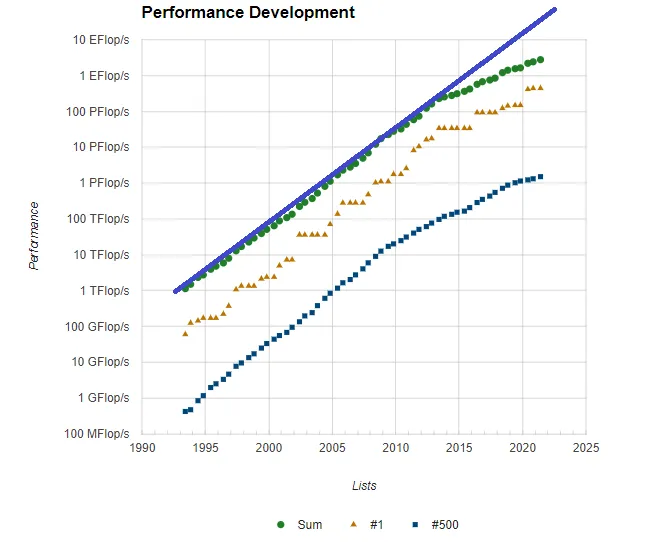Technology is progressing at an amazing rate. However, we are not seeing a massive economic impact for a variety of reasons. While there are a host of variables holding us back, one is computing.
This certainly is counterintuitive considering how much we see computing advancing. However, we are dealing with something that is slowly. Fortunately, over time, it will see a reversion to the mean. For the time being, we are going to keep falling further behind until this is solved.
Technology establishes trendlines that can take place for decades. When there is a falling off below this line, we see that an economic opportunity appears. Nevertheless, until that is filled, we all suffer the effects.
Nowhere is that less true than with supercomputers. Over the years, we can see a nice trendline established. Sadly, about the middle of the last decade, we saw a deviation from the progress we were making.
Here is a chart detailing the top 500 supercomputers and the performance development.

Added to the chart was the blue line to show what it would look like if the previous trend, which was long established, continued. Sadly, we can see the deviation from about 7 years ago, something that continues today.
One major issue is that we can see from this chart is the cost of this slowdown. Since the top 500 supercomputers are not accelerating at the same pace, we can clearly identify what is a massive economic shortfall.
Paradigm Shift
Obviously, computing is vitally important to us today. Our forward progress is dependent upon it. There are few industries where computing is not at the center of most activities. As computing advances, we are able to improve and expand these areas.
A slowdown in the acceleration of computing is putting a cap on how much economic expansion we can experience. Since so much of our research is dependent upon processing power, we see how our technological trend is also flattening out.
The reason for this situation is the fact that our present computer architecture is reaching a degree of diminishing returns. In other words, it is likely that we require a paradigm shift to occur. Of course, at this moment, we are unsure of what that will be.
One of the challenges is that computer engineers were trained to follow the same architecture for the past 50 years. For most of that time, it was very effective. However, as we are seeing, something different is required. It will take innovation and people thinking differently about what is taking place. This will happen yet it could take some time.
Economic Impact
There was a time where we would see a 10x every 4 years in the total computational power of the top 500 supercomputers. Now, we see that pace heading towards a double. In other words, it will take twice as long to 10x the total.
We can guess this has major economic impact on our us as a society. How many discoveries are not taking place as a result of our slowdown in computing? At the same time, what industries are not forming due to this?
Presently, we are seeing economy loss. As the progress of computing tapers off, the overall productivity will stagnate. Fortunately, this will reverse trend at some point.
Reversion To The Mean
We can expect a reversion to the mean. As stated, this trendline was established over many decades. It is not dead, simply off track. To get back to that, we are going to have to see a radical increase in computational power.
How will we get this? There are a variety of areas that people are working on. One of the main areas of focus is quantum computing. This is a sector where there are billions being invested. Major companies and some of the largest companies in the world are working on producing components to bring quantum computing into reality.
The economic impact from this single breakthrough could bring the total computational power of the top 500 supercomputer back to the existing trendline. That is going to produce an enormous amount of upward thrust economically.
What this tells us is that the further away from the trendline we stray, the more economic incentive there is to get us back on track. This is why companies are willing to dump billions of dollars into R&D even though the payoff is years (if not a decade or more) down the road.
Of course, it might not be one breakthrough. A paradigm shift could come from variety of breakthroughs, all complimenting each other.
Whatever the ultimate solution is, we are going to see a new paradigm that will get supercomputing back on track. We will find this is a huge boom economically which could accelerate more innovation. It is not easy to fall behind the long0term trendline but it does offer incentive to find a solution.
Where there is economic opportunity, people will look to fill the void. At this rate, we can expect a major economic thrust towards the end of this decade.
If you found this article informative, please give an upvote and rehive.

gif by @doze

logo by @st8z